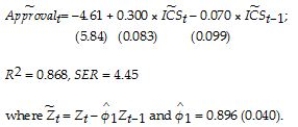The Gallup Poll frequently surveys the electorate to quantify the public's opinion of the president.Since 1945,Gallup settled on the following wording of its presidential poll: "Do you approve or disapprove of the way (name)is handling his job as president?" Gallup has not changed its presidential question since then,and respondents can answer "approve," "disapprove," or "no opinion."
You want to see how this approval rating is related to the Michigan index of consumer sentiment (ICS).The monthly survey,conducted with a minimum sample of 500,asks people if they feel "better/worse off" with regard to current and future conditions.
(a)To estimate dynamic causal effects,you collect quarterly data from 1962:I - 1998:II for the United States.You allow a binary variable for each presidency to capture the intrinsic popularity of the President.Furthermore,you eliminate observations that include a change in party for the presidency by using a binary variable,which takes on the value of one during the first quarter of the year after the election.Finally,a friendly political scientist provides you with (i)an "events" variable, (ii)a "Vietnam" binary variable,and (iii)a "honeymoon" variable,which measures the effect of a higher popularity of a president immediately following the election.(The coefficients of these variables will not be reported here. )
Assuming that consumer sentiment is exogenous,you estimate the following two specifications (numbers in parenthesis are heteroskedasticity- and autocorrelation-consistent standard errors):  t = 26.08 + 0.178 × ICSt + 0.232 × ICSt-1;R2= 0.667,SER = 7.00
t = 26.08 + 0.178 × ICSt + 0.232 × ICSt-1;R2= 0.667,SER = 7.00
(8.83)(0.120)(0.135)  t = 26.08 + 0.178 × ΔICSt + 0.411 + ICSt-1;R2 = 0.667,SER = 7.00
t = 26.08 + 0.178 × ΔICSt + 0.411 + ICSt-1;R2 = 0.667,SER = 7.00
(8.17)(0.120 )(0.089)
What is the difference between the two specifications? What is the advantage of estimating the second equation,if any?
(b)Assuming that the errors follow an AR(1)process,you also estimate the following alternative:  t = -4.61 + 0.300 × ICSt - 0.070 × ICSt-1- 0.054 × ICSt-2;+ 0.776 × Approvalt-1;
t = -4.61 + 0.300 × ICSt - 0.070 × ICSt-1- 0.054 × ICSt-2;+ 0.776 × Approvalt-1;
(5.84)(0.083)(0.099)(0.083)(0.057)
R2 = 0.868,SER = 4.45
How is this specification related to the previous ones? What implicit assumptions did you have to make to allow for desirable properties of the OLS estimator?
(c)You finally estimate the approval equation using the quasi-difference specification and the GLS estimator.  How is this equation related to the ones in (a)and (b)? What are the properties of the GLS estimator here,under the assumption that ICS is strictly exogenous?
How is this equation related to the ones in (a)and (b)? What are the properties of the GLS estimator here,under the assumption that ICS is strictly exogenous?
(d)Is it likely that the ICS is exogenous here? Strictly exogenous?
Definitions:
Psychotherapy
A form of therapy that involves talking with a mental health professional to address emotional issues and mental disorders.
Free Association
In psychoanalysis, a method of exploring the unconscious in which the person relaxes and says whatever comes to mind, no matter how trivial or embarrassing.
Repress
To unconsciously block unpleasant feelings, desires, or experiences from one's awareness as a defense mechanism.
Paraphrase
The act of rewording or rephrasing a text or statement to clarify its meaning, often to achieve greater understanding.
Q3: The large-sample distribution of <img src="https://d2lvgg3v3hfg70.cloudfront.net/TB2833/.jpg" alt="The
Q21: Randomization based on covariates is<br>A)not of practical
Q29: Under the VAR assumptions,the OLS estimators are<br>A)consistent
Q35: Homoskedasticity means that<br>A)var(ui|Xi)= <img src="https://d2lvgg3v3hfg70.cloudfront.net/TB2833/.jpg" alt="Homoskedasticity means
Q37: You set out to forecast the unemployment
Q40: Consider the special panel case where T
Q41: Under the least squares assumptions for the
Q54: In the presence of heteroskedasticity,and assuming that
Q54: In 2001,the Arizona Diamondbacks defeated the New
Q109: The Poisson distribution is a discrete distribution